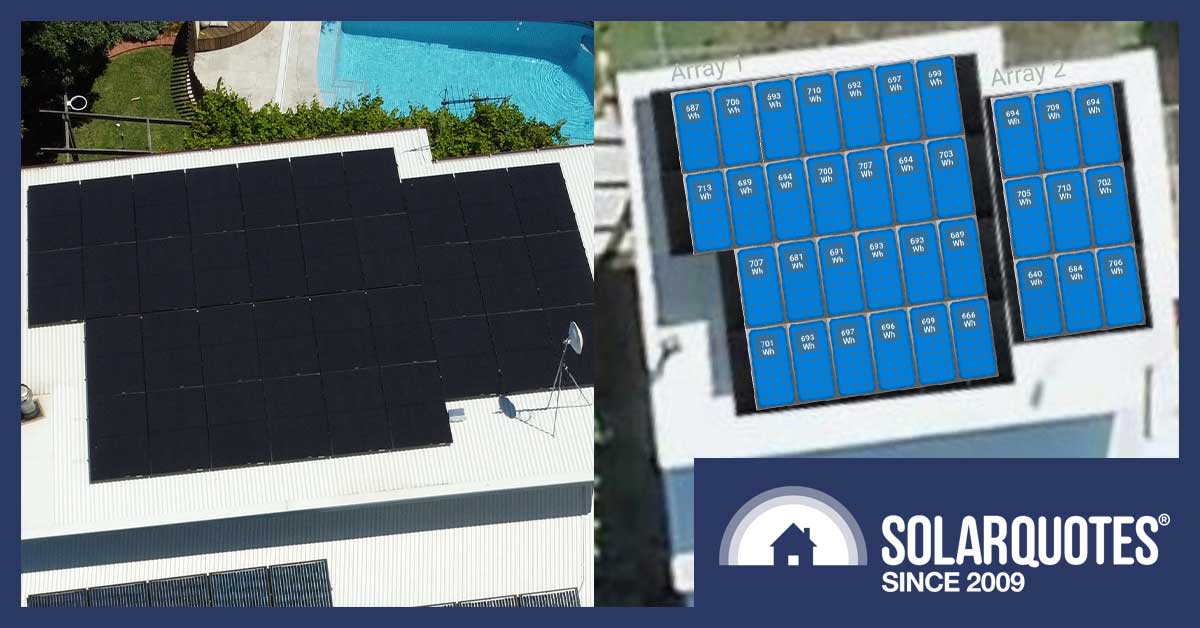
Solar panels with Enphase microinverters and panel level monitoring.
Today I’ll explore optimisers and micro inverters, just how they differ from more conventional solar gear, their advantages and their flip side: being complex and more expensive.
Like other facets of life, you can find solar has definite camps. Like the old Ford versus Holden, or maybe Collingwood vs anyone rivalry, people pick a particular technology and once they’ve chosen it can be hard to argue that there’s any other solution. When it comes to individually optimised panels, the industry calls this Module Level Power Electronics (MLPE) and in Australia, your choices are:
Microinverter Camp
- Enphase
- APS (for the brave)
Optimiser Camp
- SolarEdge (optimised string system – require an optimiser on every panel)
- Tigo (just optimisers – work with any brand of string inverter)
- iStore (conventional string system with optional optimsers)
Just What Is Optimisation?
If you’re looking to get the nth degree of yield from every single panel on your roof, then Module Level Power Electronics (MLPE) is what you want. MLPE is about tuning up the orchestra and hitting the high notes, because solar panels perform differently depending on angle, orientation, temperature and manufacture.
Identical Panels; Aren’t Actually
From the same production line, every panel made is slightly different, so quality control in mass production means items are tested for size, fit or performance; and then sorted into similar categories.
In solar, each panel is flash tested for power output to classify them. The upshot? Visually identical models can come in 400, 405, 410 and 415 watt sticker ratings.
Henry Ford made 60 million identical Model T pistons, but in reality there was a range of sizes. Grading for loose, standard and tight fit meant parts could be matched together, so fully assembled engines didn’t rattle or seize solid.
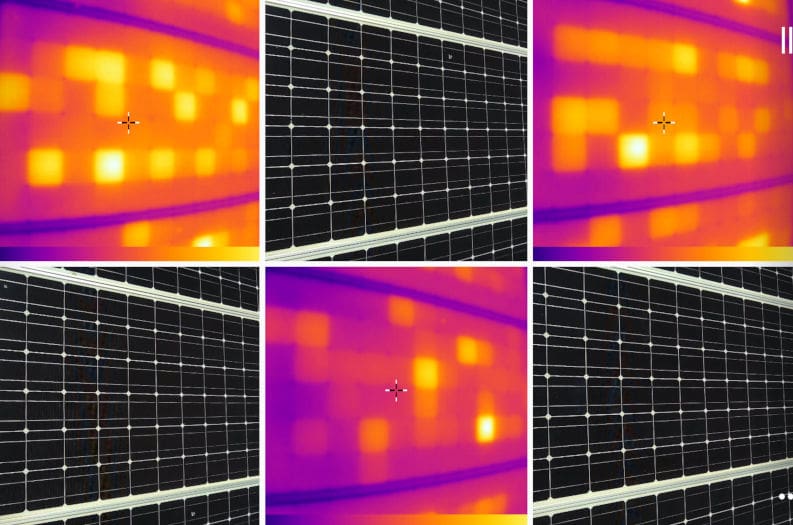
These cheap, rubbish panels were assembled with badly matched wafers. Thermal images show low performance/high resistance cells run hot, limiting the rest of the 3 series circuits in each panel.
Solar specifications used to say a panel was around 250 watts, ie plus or minus 3%. This is called a power tolerance. To differentiate themselves in the market, better quality modules began to offer positive 3% tolerance. It means that your panels do at least what it says on the tin, probably more.
When you assemble these panels into a series string, it means that the worst performer will govern how well the rest work. The chain will only be as good as its weakest link, but this becomes a bit irrelevant when 4oo+ watt panels are classed to within 2% anyway.
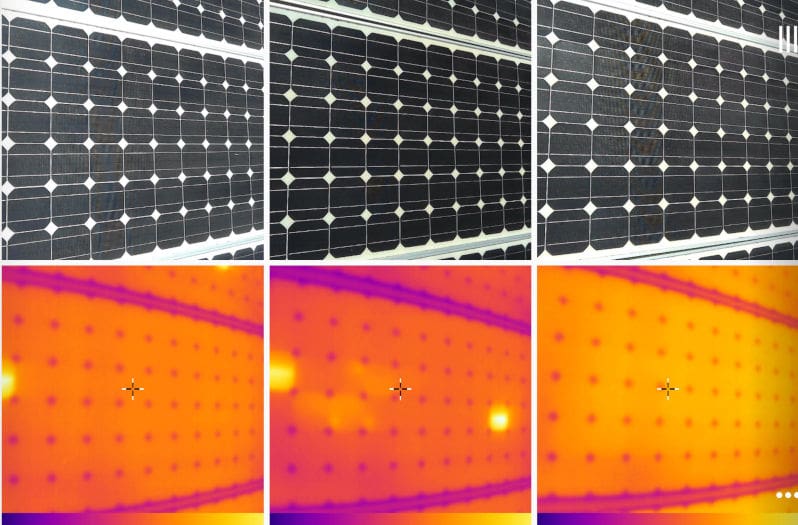
On the same roof, these much older panels show perfectly uniform cells, albeit with 3 suffering impact damage? This is the properly sorted, evenly matched quality control you get with genuine Japanese made Sharp Solar Panels.
Imagine All Your Panels In Parallel
If all the solar modules on your roof were independently optimised, instead of being chained up in a string, you could effectively harvest every single watt they’re capable of. Take two strings of 460 Watt REC alpha pure RX panels, (9.2kW) If they all over perform by 1% you’ll garner an extra 90 odd watts. Ready reckoning says that’s an extra 145kWh per year or 3 1/2 average days extra yield. Annually that’s $11 @ 8 cents for export or $72 @ 50 cents per kWh of displaced consumption.
Of course, this extra yield is handy but isn’t going to buy you a cattle station. And it doesn’t take into account the fact that optimisers or micro inverters are on the roof operating in a really hot environment where they may not be as efficient as a string inverter, which is downstairs in the garage, fan cooled hopefully.
What About Shade?
Modern panels are fundamentally better because half cell configurations are really two low current parallel panels, with more bypass diodes, under the same piece of glass. By design they perform significantly better than panels of 5 years ago. Despite this, it’s incredible that most solar panel manufacturers actually do not technically warrant their modules for installations in shaded conditions.
While optimisers on each panel can fine-tune the output of shaded single panels to contribute positively without adversely affecting the rest, the overall improvement isn’t as substantial as it once was.
Microinverters
If you have shallow roofs where running DC cables in conduit is problematic, or small complex multi level, multi orientation townhouses, then using AC wiring for individual micro inverters can really simplify installation. It’s arguably safer than 600 volts DC with an added bonus that no wall space is needed, you just connect straight to the nearest switchboard.
Though wiring is simpler, Enphase microinverters effectively rely on electrical noise for communications. High frequencies superimposed over the AC circuit can be fraught with some difficulty if there’s electrical interference from other appliances.
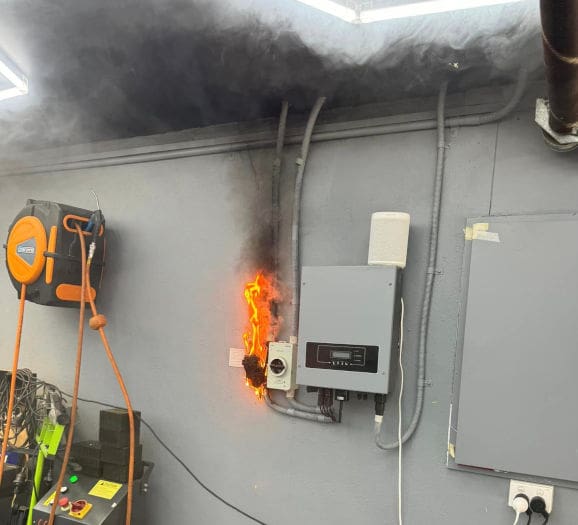
Rules have changed since this install, under new Australian standards this type of DC isolator failure is far less likely, but micro inverters eliminate the risk.
Enphase is excellent and premium products with good warranties generally don’t attract shoddy installers like cheap gear does.
The catch is that you need a healthy budget and you can’t DC couple a hybrid battery system with Enphase (or technically exceed 133% overdrive). AC coupled batteries are available but the Enphase 5p system is physically enormous per kWh stored compared to a Tesla Powerwall, with its more elegant and intuitive monitoring app.
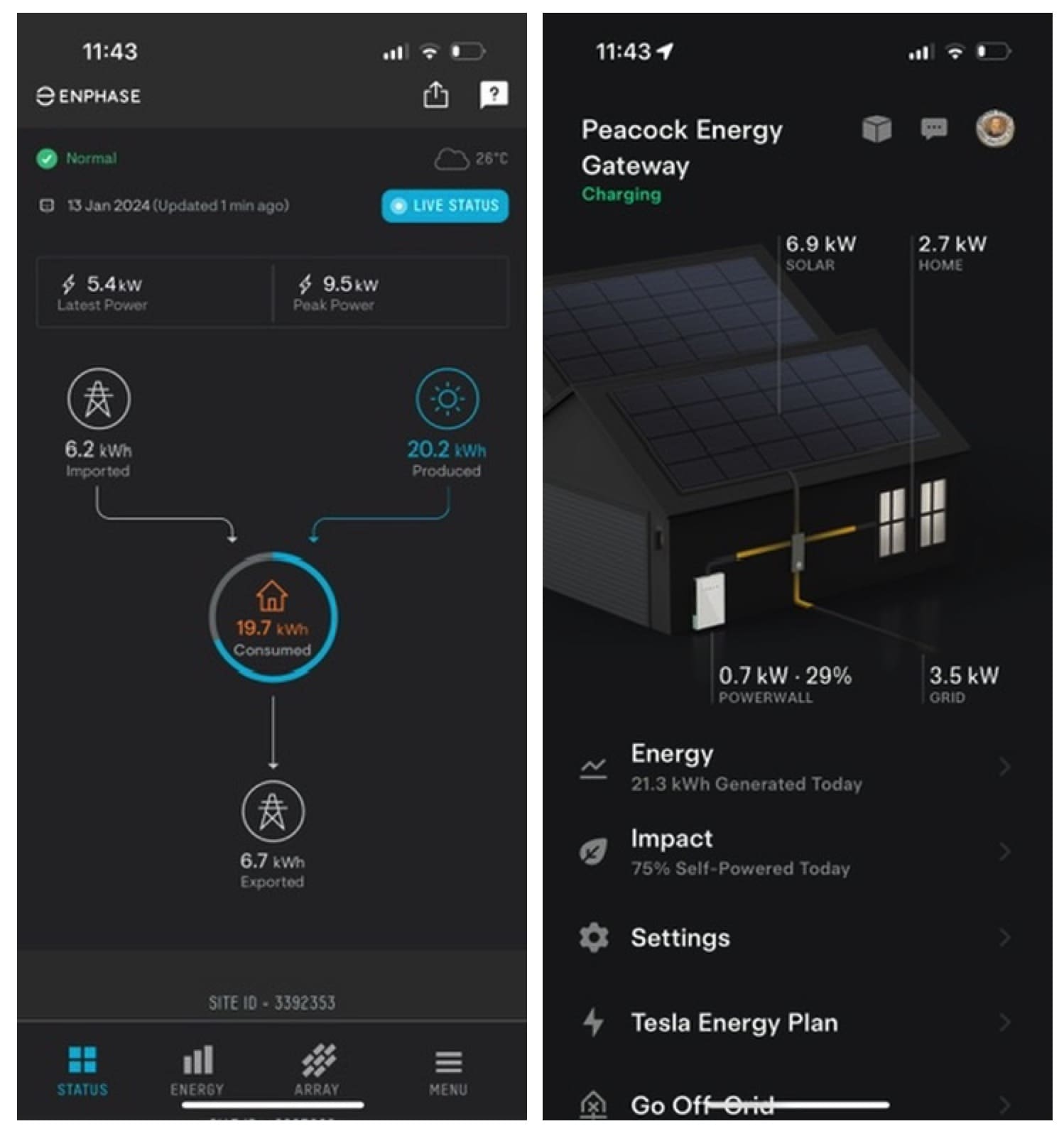
Enphase App & Tesla App home screens
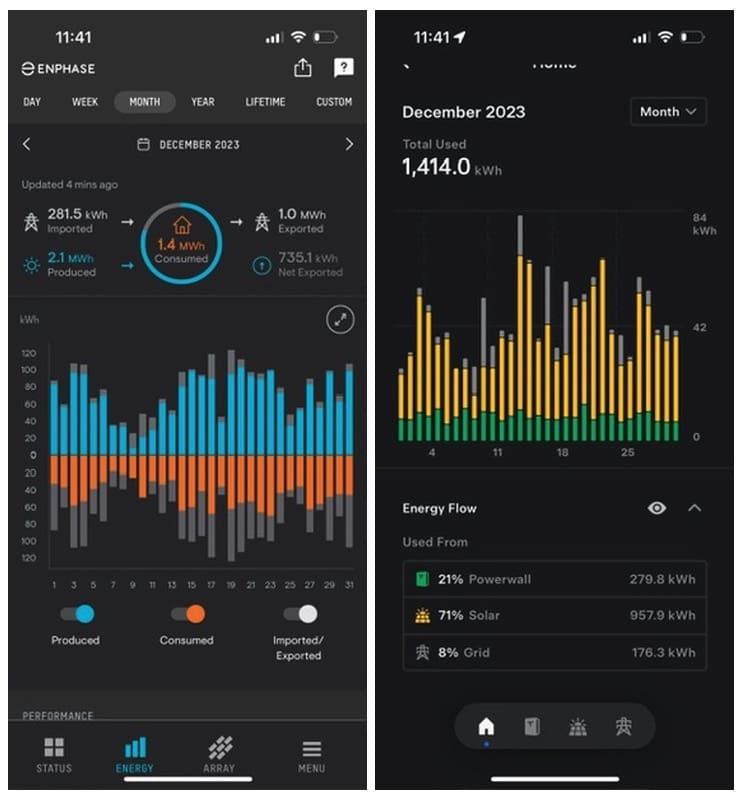
Enphase vs. Tesla app: monthly graphs
Optimisers
Instead of treating each panel as its own mini-system, optimisers adjust individual panel outputs to harmonise the entire array. A more conventional string inverter then takes care of converting the DC electricity into AC that you can use in the house. This approach means that optimised systems can work with difficult roofs, but they’re not perfectly flexible like micro inverters. Different brands have distinct methods but roughly speaking;
- Tigo TS4-A-O monitors panel output (using an extra piece of hardware you need for warranty & display) When a panel experiences shade, the Tigo offers a low resistance path for the rest of the string to shunt through, without excessive losses and stress on the bypass diodes in the panel. They’ll work with almost1 any panel and any string inverter.
- SolarEdge have a unique architecture where the inverter has a fixed input voltage, and the optimisers behind each panel are designed to buck or boost the panel output to match. They’re considered safe because if the optimisers lose connection to the inverter, they shut down and only deliver one volt each. Care must be exercised when designing the string layout and panel compatibility but they do offer some ridiculous panel oversizing and unique features like direct DC car charging.
- iStore2 take this architecture a step further with an inverter which has an adaptive input, like any other string inverter which hunts for maximum efficiency with an MPPT; however they also have optimisers which will condition the panel output for greater efficiency. The inverter doesn’t actually require optimisers and they’re more flexible than SolarEdge because of it.
What About Reliability?
Adding a layer of complexity is always fraught with some danger, especially when you’re dealing with different brands of gear. There’s examples of systems being broken by firmware updates that nobody wants to support if for instance you have replace parts.
Microinverters means more redundancy, but it cuts both ways. We’ve mentioned previously, MC4 connectors are pretty reliable but using optimisers means having twice as many potential points of failure.3 Some have optimisers built into panels themselves for simplicity, but if/when these panels/optimisers break, you’ll probably find they’re obsolete in a handful of years.4
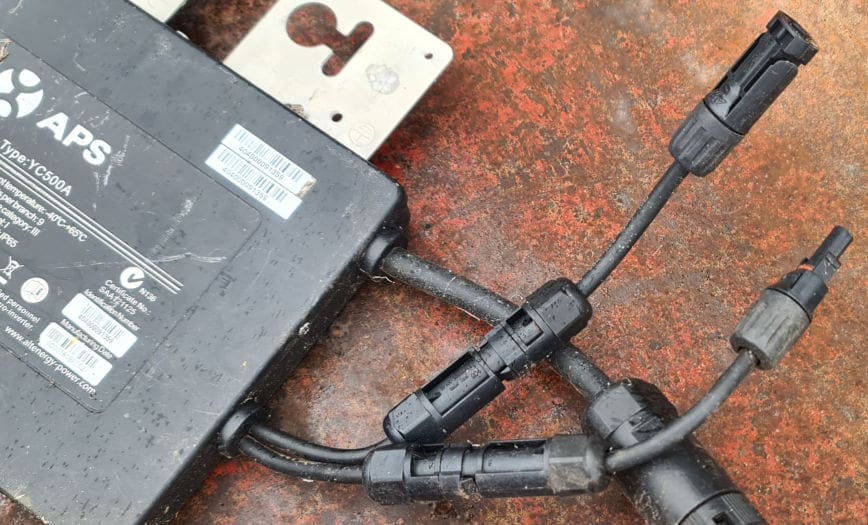
Three times more potential failure points. This APS micro inverter has adaptor leads to change the type of MC4 connector.
Panel Level Monitoring
Arguments for and against these technologies are muddied by what you might call the braggart effect. Cooking nerds may fawn over a Thermomix but I’ll argue they get conned into buying a $2000 appliance when a potato masher and my Nanna’s electric frypan does the same job. Of course nobody admits there’s a similar but less fashionable machine in the back of the cupboard or a box full of attachments you’ve forgotten exist.
Solar nerds will fawn over panel level monitoring for at least a fortnight. It’s a great selling point, people love the idea of buying it, but it seems most soon forget it exists. While having individual panel output information is novel, hiring 3 people and a scaffold to lift half of an array off the roof and replace failed equipment; is not going to be nearly as interesting. Inverters at ground level are easy to swap.
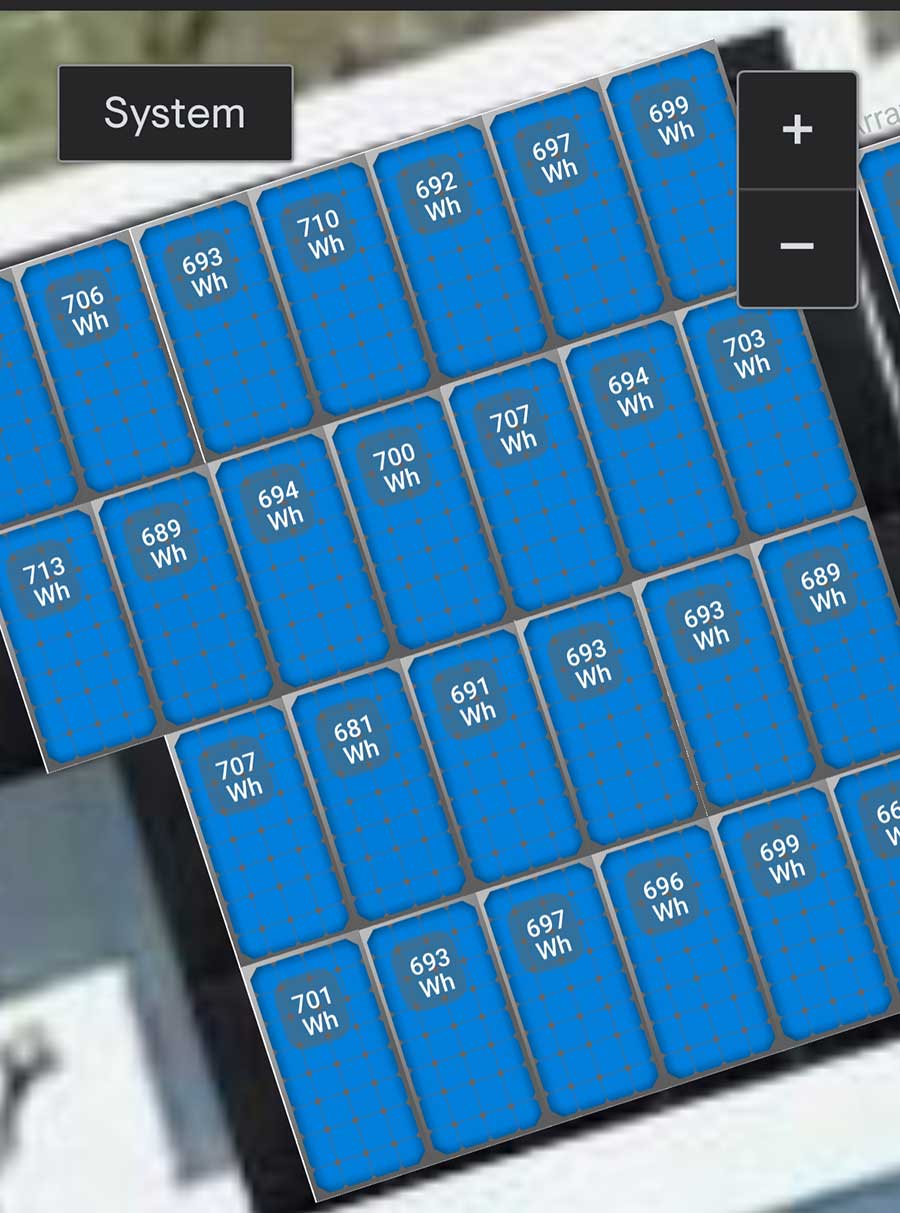
Enphase panel level monitoring
Should You Opt for MLPE?
Personally I can’t justify the expense of MLPE because I don’t have a complex roof or shade compromised outlook. However there is a niche for them, and great installers who tell me they sleep well having staked their entire operation on the technology. There’s certainly some efficiency to be had, both in yield for customers and simplified operations & support.
I would much rather spend my spare cash on an induction stove, a heatpump hot water or the highest efficiency panels you can get parked on any roof available. Even if they face the wrong way, a modern, quality string inverter will fill most roles admirably.

 RSS - Posts
RSS - Posts



I didn’t install solar panels for many years until the microinverters came in. We have huge tree shading issues. When solar panel companies rang me, I would tell them to look at my roof on Google Maps and if they could guarantee 85% efficiency, then I would look at it. It wasn’t until the microinverter came in on Canadian panels that we found a system that worked. The extra cost was quickly recouped.
I installed 20 panels 5 kw with plain inverter some 10 years ago but it basically has been a waste of time. Would probably not even paid it back. Conned we have been. Overshading from tall trees, so really not sure which way to go 1. Retro fit optimisers, 2. Add Microinverters 3. New modern panels and more with battery and BMS
REally do not know which way to go and there is so much conjecture and opinion based in above.
My only constant is large house, large oak trees and a present waste of time system
Hi Anthony,
Great article a couple of points to mention, you say that optimisers will de-rate due to the high temperatures on the roof, please consider that they are designed to be installed and operate on the roof so this is all taken into account, just like a PV module they only de-rate above 85 deg C whereas most string inverters will de-rate at around 55 deg C. SolarEdge Optimisers have a 25-year warranty which just goes to show how robustly designed they are.
I disagree with your comments about more points of failure, this is simply not true. Although there are more connections, if any connection of the PV Module to the Optimiser was poorly made or defective in some way the Optimiser would detect it and turn it off, but most importantly all of the other optimisers would keep operating. If it were a string system and, if any single MC4 connection was defective they entire string, and maybe even the entire array would shut down.
So, MLPE systems such as SolarEdge have much more redundancy than a string system, so any single fault will not shut down everything. They will also detect faulty connections that can lead to arcs or fires and turn off the PV production so that the fault is not being fuelled, unlike a string system.
I have been running SolarEdge for many years. I like the ability to be able to add panels, even if mismatched. (My installation is on a shed, so less restrictions). I am even running panels originally installed well over 15 years ago (including some with minor damage from microcracks). The ability to monitor individual panel output is very important in my case. I know some panels are 20% down, but still working. The only failure I have experienced was with an optimiser, but the rest of the system continued working until the optimiser was replaced.
My system required optimisers due to overshadowing. To my mind, in my situation they were well worth the extra expense.
The irony is that my optimisers let me know when an optimiser has failed (1of 22 optimisers in 5 years).
Regardless of that, I still like the panel level monitoring. SolarEdge system, east, north and west facing panels with some morning shading until the neighbour’s tree came down in a storm. I sometimes think Enphase would have been the better option for the added flexibility.
I’m fast approaching 2.5 years with my Enphase 7A and I panel level check frequently and will continue to do so as long as I am physically able to so. (In other words for years to come)
Amongst so many benefits of Enphase micros, it’s a great way to ensure your pv array is operating optimally.
In fact, I just checked them now. They’re all operating perfectly
We have a single storey house, with large trees to the east, north and west, and our Enphase microinverters are sure proving their worth to us.
We have significant shading issues on our roof so we’d decided that micro inverters were a must for our installation. Interestingly, both companies that provided us with quotes advised against using Enphase due to reliability issues they’d experienced.
We went with a SolarEdge system with optimisers and could not be happier. After unexpectedly adding an EV to our household we were happy to discover that the SolarEdge set up also lets us charge the car from excess solar only.
Who scammed you concerning the reliability issues of Enphase micros? Which ones have the reliability issues? What was/is/are the so called reliability issues?
Did those companies sell and install Enphase micros?
Inclined to agree. String inverters are the first port of call. Optimisers and Enphase micros are almost a compliance solution. We even retrofitted Tigo’s to a Sunpower system and had a really small boost in production. Totally not worth it as adding more panels would have given us a much larger boost with less complexity / reliability issues. If you want a small (micro sized boost). 7% during the peak winter period (Design for the worst days) and about 3% annually is what we figured we were getting. This was on a big off grid job with terrible shading to the north in a lower latitude.
Think your article is pretty spot on. If we had a simple unshaded roof I wouldn’t touch micros or optimisers with a ten foot barge pole. However with short multiple orientations and varied shading through the day I think we made the right choice.
Panel level monitoring is probably mostly a great marketing tactic. Unfortunately solar edge charge an extra privilege for this. At $300 I’m not certain we would recoup the costs of being reminded to trim a tree every now and then when the output gets too low.
Great to read there are more options than just Enphase and Solar Edge now too.
Pros for Enphase microinverters.
1. Easy to expand the system with different rated panels – this has been a really big advantage for us and the one of the main reasons I would recommend it.
2. Replacing a microinverter when it goes bung is also very straight forward – we have had one done no problem.
3. When an inverter goes bung it is a minor inconvenience – not a major issue.
4. Connects seamlessly with our Powerwall, so not sure I understood the article correctly.
5. Great software and monitoring and support
Cons
1. 10% cost premium from our local installer – last time I checked.
Cons. You state 10% cost premium for Enphase microinverters. Did you or your installer factor in their 15 year warranty against 10 year for pretty much all string inverters?
Check again. Might be cheaper or the same prorata cost.
I suggest you move it to Pros and state that the Enphase micros START with a 15 year warranty.
It’s good to see the practical aspect of your posts where simplicity, longevity and cost weigh in heavily against those who just see “efficiency” of energy alone as the holy grail.
It’s crazy the number of people who think that if you waste sunshine capture you are saving energy, but to waste (less energy efficient “ the electricity that can be generated from that sunshine you are committing a “crime against the planet” and will bring doomsday.
One major reason I am considering microinverters is the greater inherent safety of having an AC cabling system on/through the roof/house. This fact has been largely ignored in this article. Great to read the many positive posts on Enphase.
Hi Mike,
It’s there in the text I assure you, if fact Finn himself has micros on his own roof. Knowing how roof top isolators are prone to causing fires, I don’t think it’s been a silly idea, however the elimination of these in recent standards makes everybody a lot safer.
In many case it’s just preference, so don’t be discouraged, I just offer what I think is a rounded opinion.
Maybe I’m not technologically competent enough to understand ,, but what is the conclusion of this article? Is the conclusion to install panels with microinverters or not? I’m more confused than before about what to do on my split roof, multi orientation shaded townhouse? Every installer I speak to gives me a different story and now solar quotes seems to be suggesting to forget about microinverters.
Hi Tony,
Split roof, multi orientation, shaded townhouse is the ideal niche for microinverters, especially if you can only get one or two panels on a particular face.
Clever design, using an inverter like Fronius which can handle parallel arrays, is sometimes just as good if you want a hybrid system with a battery.
Bottom line is to put them everywhere.
https://www.solarquotes.com.au/blog/roof-orientation-solar-australia/
Hi Anthony,
Given that AU has moved to full digital TV broadcast now, does the issue of Maxim Chip integrated panels posing issues, still relevant?
If not, are there any Maxim Chip panels available for sale now in Q3 2024?
Also, there is a new panel – AIKO which claims to handle shade better. Do you have any thoughts on it? With its shading optimisation and best in class 24.3% efficiency, All Back Contact panels, pure black appearance – have we got a winner at hand?
Hi Karthick,
I couldn’t tell you maxim chips sorry.
AIKO seem to be a nice product. They have people on the ground promoting them here but as far as I’m aware they still don’t have an Australian office so we hesitate to recommend them until they at least meet that basic requirement.
Hello Anthony
You mentioned above about split roofs being a niche for split roofs. We are planning to install a solar system (probably without battery) and our townhouse has several angled roofs. To get 6.6 or more we would need to emulate a neighbours installation and have some panels on the front side with a South-West angle to complement the panels on the rear that would get East, North and Northwest sun. Is this what you mean by a split roof niche?
Also, I have seen some houses with panels placed at an angle forming a triangle with the roof in order to get more panels. Is this a good idea?
Thanks in advance.
Hi Gary,
Where Enphase are ideal is when you have multiple different orientations and very little space. ie there’s only room for one, two or three panels per facet of roof.
String systems can be wired across planes, say a group of two on one roof and a group of 4 more on another roof… provided they’re facing the same way.
Have a read here 😉
https://www.solarquotes.com.au/blog/solar-roof-builders/
https://www.solarquotes.com.au/blog/roof-orientation-solar-australia/
https://www.solarquotes.com.au/blog/self-cleaning-solar-panel-pitch/